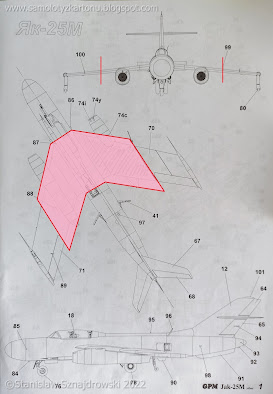| Budowa Jaka idzie ostatnio powoli. Raz, że nie miałem za bardzo czasu, dwa, że za gorąco. Ciężko się klei w upałach. Ręce się pocą i klej za szybko schnie! Mimo wszystko udało mi się skleić i zamontować skrzydła. Zapraszam do relacji! | The build of Yak-25 has been going slowly recently. Primarily because I didn't have too much time. Additionally, because it was too hot. It is hard to build something during such hot weather. Despite everything, I managed to assemble and attach the wings. Enjoy the next part of the model build report! |
| Konstrukcja skrzydeł nie jest w tym przypadku zbyt skomplikowana. Jak-25 jest średniopłatem ze skośnymi skrzydłami o kącie skosu 45 stopni i ujemnym wzniosie -5 stopni. Swoją drogą bardzo lubię określenie "ujemny wznios", taki "plus ujemny". Po angielsku brzmi to jakoś sensowniej (anhedral - ujemny/ dihedral - dodatni) W każdym razie ta prosta konstrukcja, została przez autora nieco utrudniona. Jak już wspomniałem, autor nie wydaje się być gorącym zwolennikiem szkieletów i stosuje raczej zasadę "im mniej tym lepiej". Moim zdaniem, zaprojektowany przez niego szkielet nie zagwarantuje odpowiedniej wytrzymałości. Po pierwsze, szkielet nie obejmuje całych skrzydeł - dźwigary sięgają od kadłuba do połowy skrzydeł, kończą się kawałek za zewnętrznymi krawędziami gondol silnikowych. Zaznaczyłem na rysunkach montażowych dokąd mniej więcej sięga szkielet. Co z pozostałą częścią skrzydeł? Na końcówkach znajdują się golenie z kółkami bocznymi, na czym mają się one podpierać? Należy przypomnieć, że pod skrzydłami będą umieszczone wspomniane gondole silnikowe, które również będą obciążać skrzydła. | The construction of the wings is not too complicated in this case. The Yak-25 is a mid-wing aircraft with a sweep wing angle of 45 degrees and an anhedral of -5 degrees. This simple structure was somewhat hampered by the author. As already mentioned, the author does not seem to be an ardent supporter of frameworks and rather follows the "less is better" principle. In my opinion, the frame he designed will not guarantee adequate strength. |
| Po drugie - montaż do kadłuba pozostawia wiele do życzenia - dźwigary nadające skrzydłom odpowiedni wznios należy wsunąć w kadłub i załamać pod kątem 45 stopni, co oczywiście znacznie je osłabia. Przyznam sie, że wsuwając je w szkielet połamały mi się nieco na zagięciach, jeden odpadł kompletnie. | Secondly -
assembling to the fuselage leaves much to be desired - the spars giving the
wings the right anhedral should be inserted into the fuselage and bent at an angle
of 45 degrees, which of course significantly weakens them. I admit that by
inserting them into the skeleton, I broke a bit on the bends, and one fell off
completely. |
| Postanowiłem
nieco ulepszyć, a właściwie wzmocnić te konstrukcję. Zbudowałem sobie szablon montażowy pozwalające zachować odpowiedni wznios. Dźwigary główne przedłużyłem
tak aby sięgały do końca skrzydła. Przednie wykonałem z dwóch warstw tektury 1mm i wzmocniłem je cyjanoakrylem. Wkleiłem
pomiędzy elementy nadające odpowiedni skos - w części wewnętrznej były to
elementy zaprojektowane przez autora, na zewnątrz moje. Uzyskałem sztywną i całkiem stabilną konstrukcję. Poszycie skrzydeł było stosunkowo proste, każde skrzydło składa się z dwóch elementów i paska łączącego. Nie było tutaj najmniejszych problemów ze spasowaniem. Powierzchnię obu skrzydeł wzmocniłem podklejką z cienkiego papieru wklejonego na butapren. Na dolnych powierzchniach obu płatów znajdują się reflektory, które wkleiłem od wewnątrz. | I decided
to slightly improve, or actually strengthen this structure. I built myself a
mounting template that allows me to maintain the appropriate height. I extended the
main spars so that they reached the end of the wing. The front ones were made
of two 1mm cardboard layers and reinforced with cyanoacrylate glue. I glued the
elements to the appropriate slant between them - on the inside they were
elements designed by the author, and on the outside they were mine. I obtained a
rigid and quite stable structure. The sheathing of the wings was relatively simple, each wing consisted of two elements and a connecting strip. There were no problems with matching here. I reinforced the surface of both wings with a thin paper liner pasted on butaprene. There are reflectors on the lower surfaces of both wings, which I put on from the inside. |
| Gotowe poszycia nasunąłem na szkielet niczym skarpetki na stopę. Weszło gładko. Nie podoba mi się to, że brakuje tutaj elementów stanowiących przejście kadłub-skrzydło. Podobnie było w przypadku stateczników poziomych. Brak tych elementów, powoduje, że widoczne są jak na dłoni wszelkie niedociągnięcia przy spasowaniu na styku powierzchni poszycia skrzydeł z kadłubem. Starałem się jak mogłem, żeby to połączenie wyszło jak najlepiej. Na dziś to już wszystko, ciąg dalszy nastąpi. | I slipped the ready-made covers over the framework like socks on foot. It came in smoothly. I don't like the fact that the fuselage-wing transition elements are missing here. It was similar in the case of horizontal stabilizers. The lack of these elements means that all shortcomings in the fit of the wing plating surface with the fuselage are clearly visible. I tried my best to make this combination as good as possible. That's all for today, to be continued. |

.jpg)

.jpg)
.jpg)
.jpg)
.jpg)
.jpg)
.jpg)
.jpg)
.jpg)
.jpg)
.jpg)
.jpg)
.jpg)
.jpg)
.jpg)
.jpg)
.jpg)
.jpg)
.jpg)
Brak komentarzy:
Prześlij komentarz